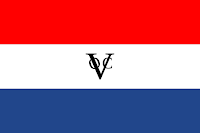37) Joost Schouten was one of the leading colonial administrators of the Dutch East Indies Company, the VOC, in the early 17th century. The VOC was the biggest trading organisation in the world at that time. It was founded to obtain spices and luxury goods from East Asia for the European market. Its operations spread from the Indonesian islands to Siam (modern Thailand) and Japan.
Joost Schouten joined the VOC in 1622. He was posted to their trading post at Ayutthaya in Siam. Shortly after he arrived East Asia trade was becoming unprofitable and the Ayutthaya post was closed down. Joost was chosen by the company to remain to buy and store merchandise and to act as a diplomatic agent. Two years later the post reopened.
 |
| The flag of the Dutch East Indies Company (the VOC) from 1630. |
The VOC closed its Ayutthaya post again in 1629 and Joost returned to Japan as their Dutch envoy. At this time the shogun, the military ruler, of Japan was Tokugawa Hidetada, though he had actually abdicated his powers to his son 38) Tokugawa Iemitsu (1604-1651).
Diplomatic relations between Japan and Siam were becoming strained, particularly after the usurpation of the Siamese throne in 1629. Japanese nationals were being victimised in Siam and Shogun Iemitsu refused to receive a Siamese diplomatic mission. This led eventually to the foreign policy adopted in Japan in 1641 that effectively cut off Japan from the rest of the world.
Joost Schouten was on the move again, and back to Siam, and the Ayutthaya trading post was opened once again. Joost was appointed its “opperhoofd”, the chief executive officer. On several occasions Joost was appointed ambassador and trade negotiator to the king of Siam.
 |
| The emblem of the Tokugawa dynasty. |
Joost Schouten’s downfall came in July 1644. He had been reported to the VOC for homosexual acts and he was put on trial with several of his partners. Joost pleaded guilty and admitted to having sex with men since his first arrival in Siam some 22 years earlier.
Homosexuality was a capital offense for the Dutch. Those found guilty were either burned at the stake or drowned. Joost was found guilty and sentenced to be burned at the stake. His partners were sentenced to be drowned. However, because of Joost Schouten’s distinguished service to the VOC they decided he deserved to be spared the pain of his punishment, so they strangled him to death first and then burned his corpse at the stake.
Whether Shogun Tokugawa Iemitsu ever heard of Joost Schouten’s fate is uncertain. Japan had a totally different attitude to male homosexuality. It was similar to the relationships of ancient Greece in which adult men took younger lovers. The Japanese called their same-sex tradition “shudo” or “”wakashudo” and was common practice among the samurai class.
Even though Shogun Iemitsu had several wives and numerous female concubines he is also known to have had at least three male partners under the system of shudo. One story goes that as a child Iemitsu became the boy lover of an older courtier named Sakabe Gozeamon. In 1617, at the age of 13, Iemitsu was installed as heir to the shogunate. It was now expected for him in due course to take his own younger lover. Instead he and Gozeamon continued to be partners. One day in 1620, as the couple were sharing a bath, Iemitsu noticed that Gozeamon was showing a lot of attention to a younger courtier. He murdered Goeamon in a jealous rage.
Shogun Iemitsu is thought by some modern European historians to have preferred sex with men despite his many wives, concubines and children. His most famous son eventually became shogun himself in 1680. This is a man I have written about before because of his introduction of laws protecting dogs. Consequently he is known as the Dog Shogun, but his official name was 39) Tokugawa Tsunayoshi (1646-1709).
I won’t repeat what I wrote in that earlier article, but I’ll mention a national festival which became popular during his rule and is still celebrated on 15th November. The festival is called Shichi Go San, which literally means “7, 5, 3”. It celebrates the various stages in a child’s development at those ages.
Tradition says that Shichi Go San was made popular by Shogun Tsunoyoshi in celebration of his own son and the idea soon spread. It is said he set the festival date to 15th November, the date of an old festival that celebrated he harvest.
This brings me to perhaps the most well-known harvest celebration which also originated in this period, the Thanksgiving in the American colonies. We’ll continue with an American colonial contemporary of Shogun Iemitsu and Joost Schouten, who shared the latter’s fate of execution for sodomy, 40) William Plaine (c.1595-1646).
Next time on “80 More Gays”: We take a break and catch up on the first 39 “Gays” before continuing with number 40 later in the month.
No comments:
Post a Comment